

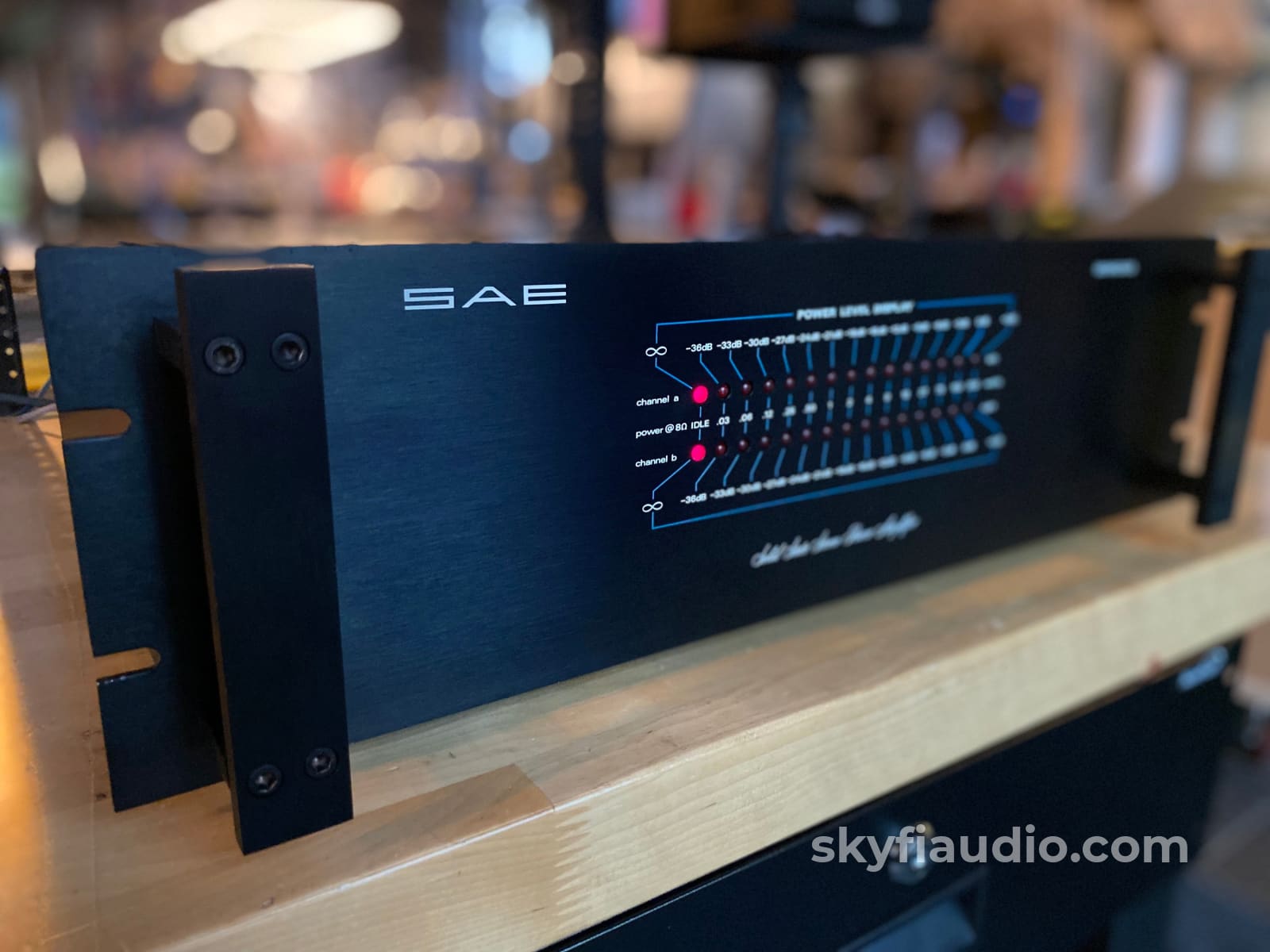
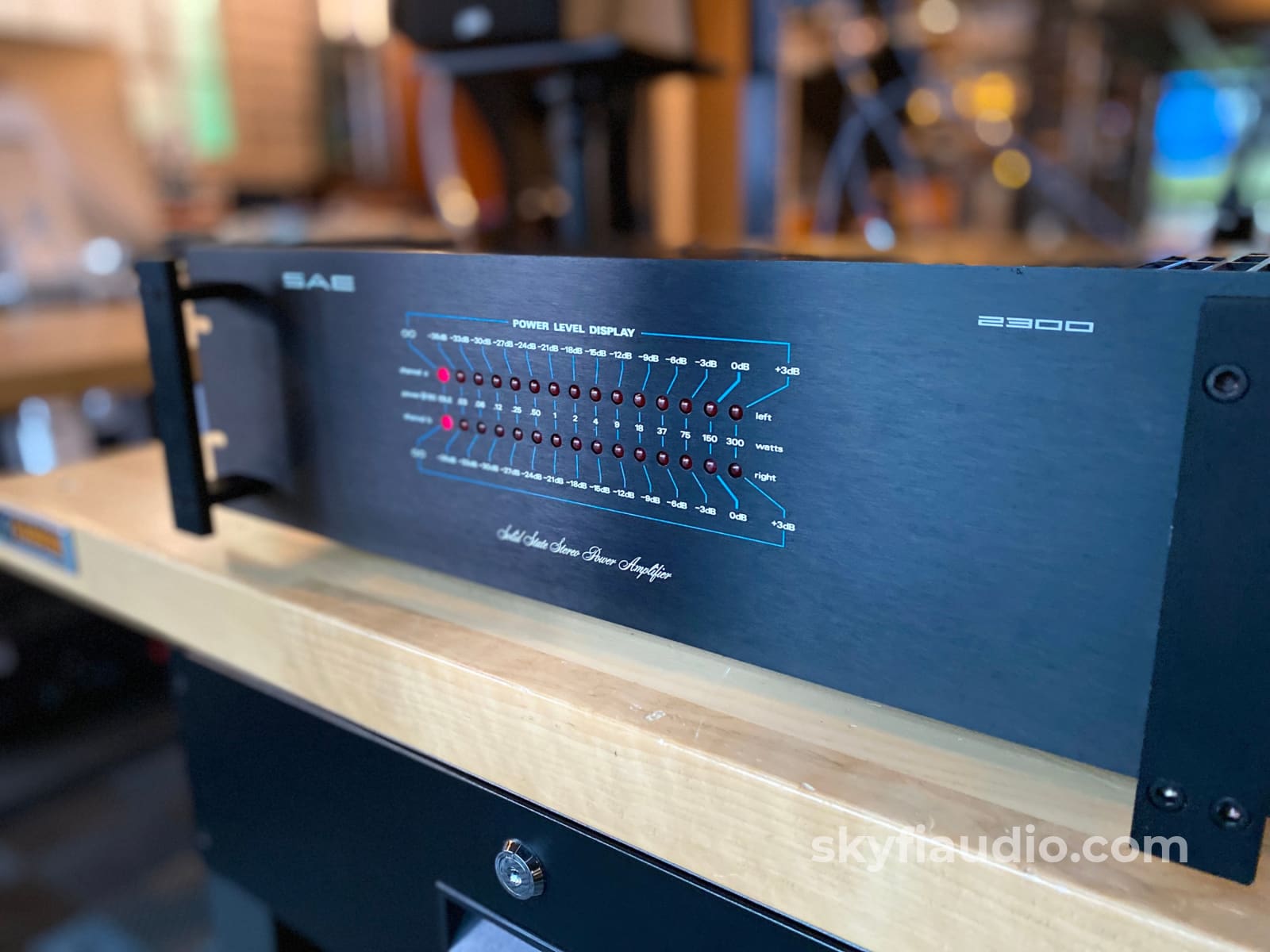
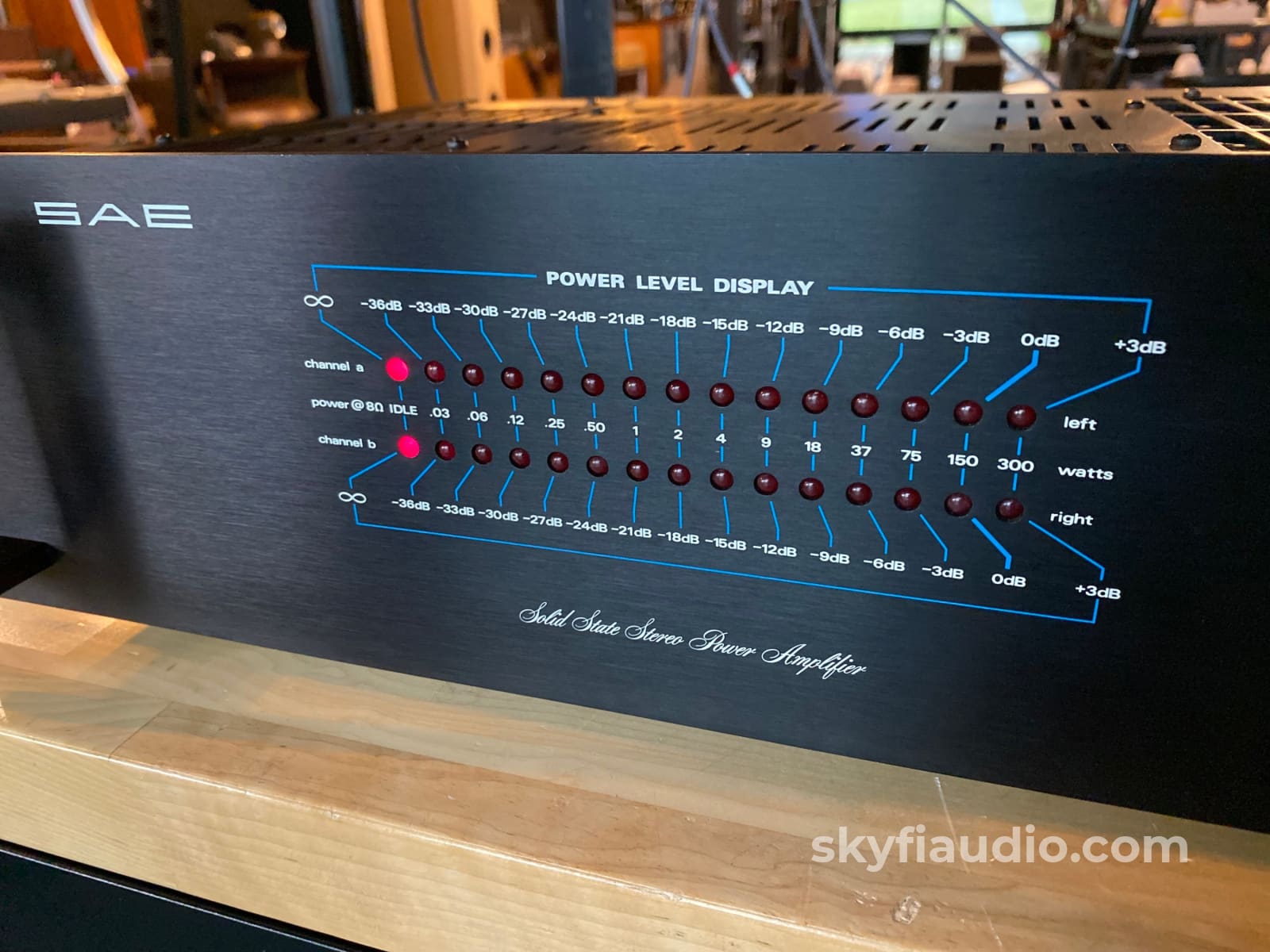
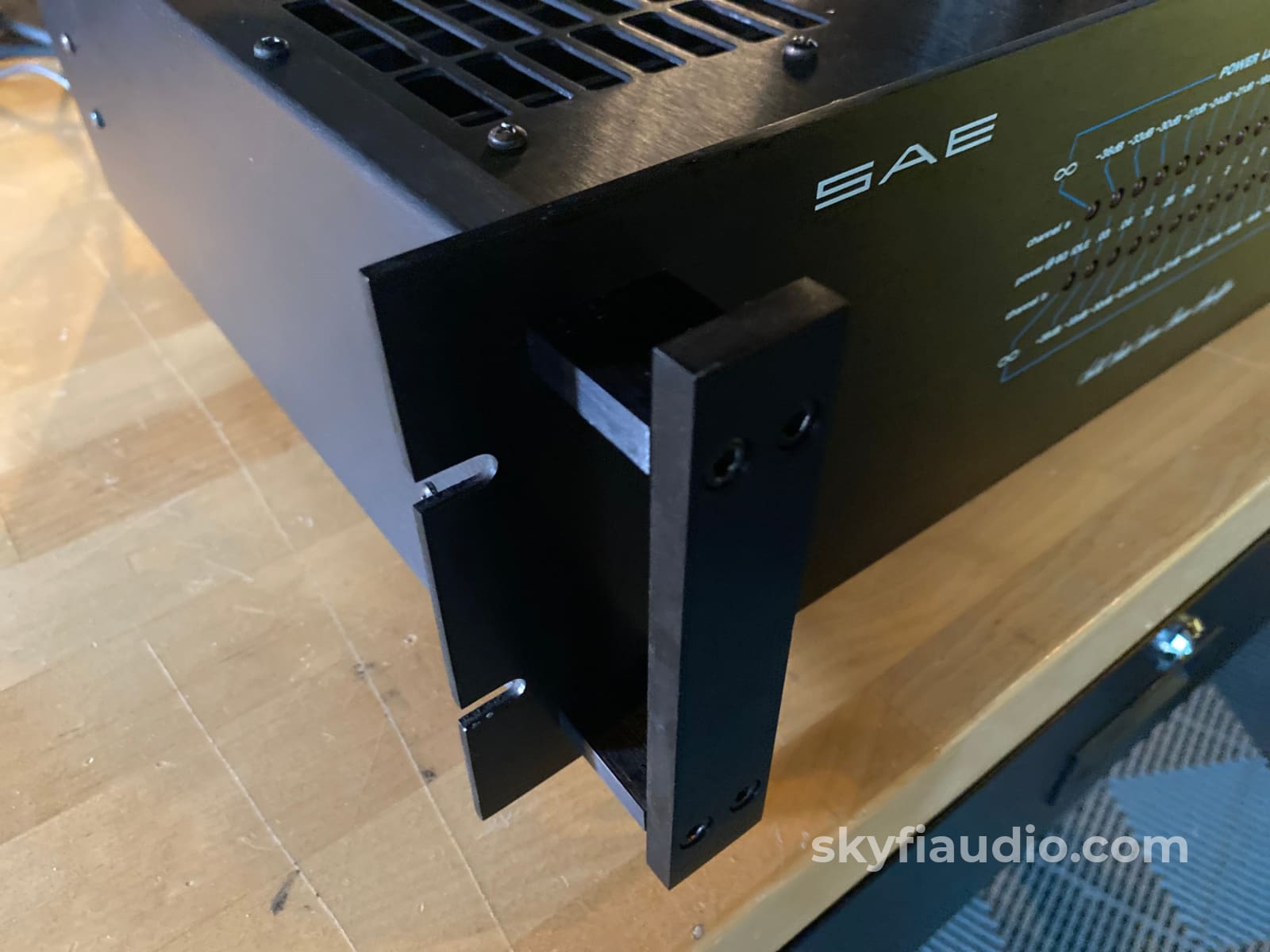




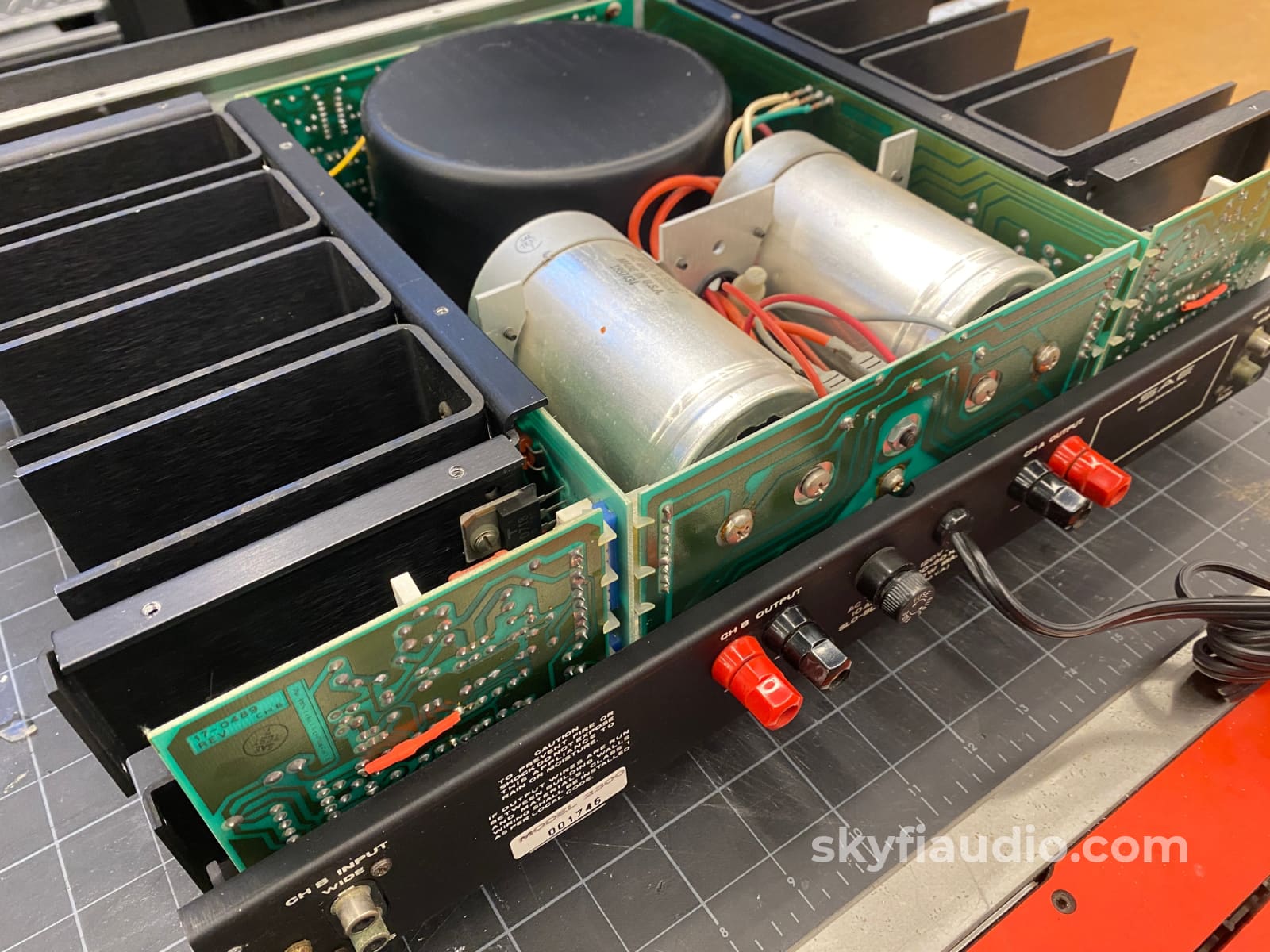

SAE 2300 Vintage Amplifier, 150W x 2
Free Shipping on Most Electronics - Excludes Speakers and Items Requiring Freight - Contiguous U.S. Only
Pickup currently unavailable at SkyFi 479

SAE 2300 Vintage Amplifier, 150W x 2
SkyFi 479
479 South Broad Street
Glen Rock NJ 07452
United States
General:
150W variant of this well regarded series from SAE.
This super clean sample arrived in perfect working condition in need of a light cleaning and thorough testing in our lab and long term test bench.
It performed admirably throughout and presents really nicely with the bright LED meters and beefy aluminum faceplate.
We were also impressed by the internal layout and build quality.
Brand Background:
Scientific Audio Electronics (SAE) was officially commenced in 1968 with a Partnership Agreement between Ted Winchester, Morris Kessler and Beth Winchester. They needed a logo, so Ted took out some Bishop Graphics PC board drafting tape and designed the stylized "S" and "E" symmetrical with the "A", SAE was born.
The Mark Two was no beauty, but it didn't have the "transistor sound" like other amplifiers of the day. Still it was difficult to sell an "orphan" power amp to the audio emporiums of the day. Their customers wanted the Marantz and Macintosh full-line with front panels/rack cases look. That changed with a review in Stereophile. Gordon Holt was reluctant at first to review the "orphan" amplifier that was not available nationally. On the telephone, in effect he said, "Well you (Ted) have made me curious and either you and your friends all have tin ears if you and they think it's the solid-state equivalent of the Marantz Nine or you've made the only solid-state amp worth buying. Gordon's most generous praise of the Mark Two in Stereophile most likely started the SAE legend.
In the early 70's, Ted was designing and manufacturing graphic equalizers separately under Linear Transducer Designs (LTD) that SAE marketed through the mid 70's. All LTD manufactured SAE equalizers and SAE preamp-equalizers are identifiable by the "Copyright LTD 19XX" on every circuit board except the Mark 1B.
Along the way, Morris was joined by the likes of the great Ed Miller and James Bongiorno, to name just a couple. Morris sold SAE, Inc. in 1988 to a company that in turn sold it to DAC. They were trying to reach the masses and had the SAE TWO line built overseas. It was the beginning of the end for the SAE banner.
James Bongiorno started GAS (Great American Sound) which also built some classic amps, like the Ampzilla & Grandson. Bongiorno sold GAS and started a third company, Sumo, and designed still more classic amps, and a tuner called Charlie the Tuner. Then in June of 1994 Morris Kessler and Mike Pontelle joined under the banner of Amplifier Technologies, Inc. ( ATI ).
For almost two decades, SAE made some of the best known home audio amplifiers. In the early Seventies, if one wanted the best in solid-state amplification, SAE came to mind. Known then internationally as purveyors of open and musical products, SAE lingers in the minds of audiophiles old enough to remember as a company that really produced. These amps were so popular, they took Japan by storm way before single-ended tube amps became retro-cool in the land of the rising Sun.
Ownership:
Single Owner
Connections:
RCA Inputs and 5-way speaker binding posts
General Sound:
Neutral sound with little to no coloration
Cosmetic Condition:
7 - Some Wear and Light Scratches
https://skyfiaudio.com/pages/our-rating-scale
Working Condition:
Working perfectly and tested in our lab.
Included:
Just the unit and power cord
Packing:
Will be packed using our highly developed in-house process and custom packing materials.
Dimensions:
5.25 x 19 x 12.5 inches
Weight:
35.0
Age:
1978
Reviews:
http://www.hifi-classic.net/review/sae-2401-264.html
Recommended Cables:
Kimber Kable - RCA Interconnects - Better
Kimber Kable - RCA Interconnects - Best
Kimber Kable - Speaker Cables - Better
Kimber Summit Series Monocle XL Speaker Cables (PAIR) - Best
Kimber Summit Series BiFocal XL Bi-Wire Speaker Cables (PAIR) - Best If Applicable
Kimber Kable - Power Cords - Better
Testing Process:
We start with a visual inspection of all internal components to make sure that there are no signs of heat stress or damage. Capacitors are checked for telltale signs of predictive failure including bulging, shrunken wrappers, or physical leakage. We also inspect the PCBs for discoloration from resistors or transistors that may have been running hot. On vintage units we often spot check select capacitors for value and ESR.
If the amplifier passes visual inspection, we move on to a controlled power on sequence using a Sencore safety analyzer to monitor current draw in real time. Once the amplifier is determined to be safe to operate, we connect it to full AC mains for function and power testing. We connect the speaker outputs of the amplifier to a Sencore PA81 Power Analyzer which acts as a dummy load, DC offset monitor, and oscilloscope interface. We start with a low level 1KHz test signal at the amplifier’s input and slowly increase its amplitude while monitoring the output on an oscilloscope for signs of noise, clipping, distortion, or improper channel balance. We continue increasing the signal level until the amplifier reaches clipping. At this point we take an output power measurement and compare it to the spec sheet of the amplifier to verify proper performance. If the device under test has both balanced and single ended inputs they are both tested at this time. We finish off the bench evaluation with a 1KHz square wave check and a 20Hz to 20KHz sine sweep to assess the amplifier’s frequency response characteristics. This battery of tests will usually reveal if the amplifier has any issues that need further attention.
Before the device leaves the bench, we perform a listening test with actual music using a variety of preferred test tracks. Our benches are outfitted with familiar monitor speakers which help us identify inconsistencies that will not always show up on our test gear. The main things that we are listening for are hum or noise with no signal present, proper center image, clicks, pops, or any other obvious undesirable audio characteristics.
If the unit passes all of these tests it is moved to our long term testing rig where we simulate real word operating conditions for 6-8 hours. This allows us to monitor the unit for signs of thermal runaway or intermittent issues that only crop up when the unit has fully come up to temperature."
Specs:
Power Output:
150 watts per channel into 8Ω (stereo)
Frequency Response:
20 Hz to 20 kHz
Total Harmonic Distortion:
0.05%
Input Sensitivity:
1.5V
Signal to Noise Ratio:
100 dB
Choose options












